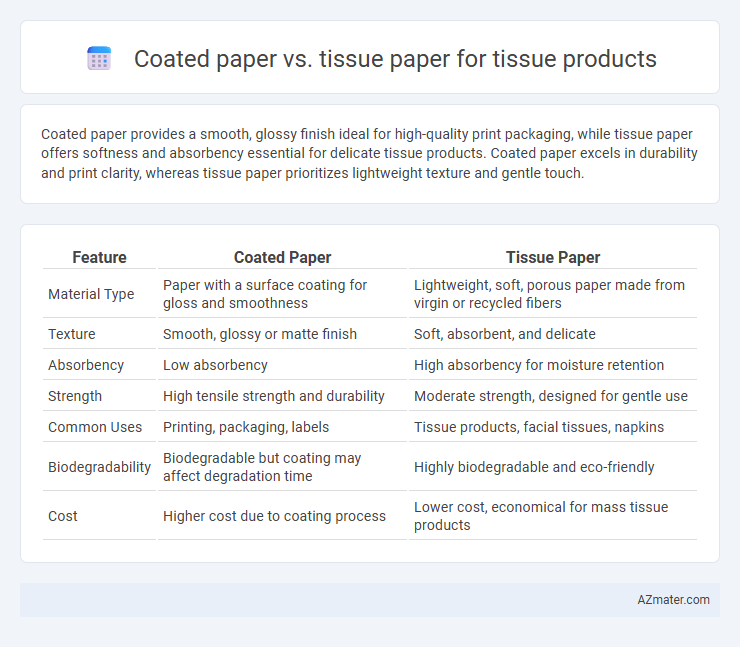Coated paper provides a smooth, glossy finish ideal for high-quality print packaging, while tissue paper offers softness and absorbency essential for delicate tissue products. Coated paper excels in durability and print clarity, whereas tissue paper prioritizes lightweight texture and gentle touch.
Table of Comparison
| Feature | Coated Paper | Tissue Paper |
|---|---|---|
| Material Type | Paper with a surface coating for gloss and smoothness | Lightweight, soft, porous paper made from virgin or recycled fibers |
| Texture | Smooth, glossy or matte finish | Soft, absorbent, and delicate |
| Absorbency | Low absorbency | High absorbency for moisture retention |
| Strength | High tensile strength and durability | Moderate strength, designed for gentle use |
| Common Uses | Printing, packaging, labels | Tissue products, facial tissues, napkins |
| Biodegradability | Biodegradable but coating may affect degradation time | Highly biodegradable and eco-friendly |
| Cost | Higher cost due to coating process | Lower cost, economical for mass tissue products |
Overview of Coated Paper and Tissue Paper
Coated paper features a surface layer of clay or polymer, enhancing smoothness and print quality, making it ideal for high-end packaging and labels in tissue products. Tissue paper is soft, lightweight, and highly absorbent, designed primarily for hygiene and comfort in products like facial tissues and toilet paper. Key differences include coated paper's durability and printability versus tissue paper's softness and absorbency, which directly impact their roles in tissue product manufacturing.
Key Differences in Material Composition
Coated paper contains a layer of pigment or polymer to enhance surface properties, providing a smooth finish and increased durability, while tissue paper is made from thin, porous cellulose fibers designed for softness and absorbency. Coated paper uses fillers like clay or latex to improve printability and resistance, whereas tissue paper relies on loosely bonded fibers for flexibility and gentle texture. The fundamental difference lies in coated paper's engineered surface for protection and aesthetics, contrasting with tissue paper's lightweight, delicate structure intended for comfort and hygiene applications.
Production Processes Compared
Coated paper production involves applying a surface coating of pigments and binders to improve smoothness, brightness, and printability, requiring specialized machinery for coating, drying, and calendaring. Tissue paper production emphasizes softness and absorbency, using lightweight pulp fibers and a creping process to create texture and flexibility, with less emphasis on surface coatings but meticulous control of fiber bonding and drying techniques. The coated paper process is more complex and capital-intensive, targeting product durability and appearance, while tissue paper production prioritizes gentle handling and mechanical creping to achieve softness and comfort for hygienic use.
Absorbency and Softness: Performance Analysis
Coated paper typically offers lower absorbency but higher surface smoothness compared to tissue paper, making it less suitable for products requiring high liquid retention. Tissue paper excels in absorbency due to its porous fibrous structure, which allows efficient moisture capture and retention, critical for hygiene and comfort applications. Softness in tissue paper is enhanced through specific fiber treatments and embossing techniques, providing a gentle tactile experience absent in coated paper, which tends to feel stiffer and less pliable.
Printing and Customization Capabilities
Coated paper offers superior print quality with vibrant colors and sharp details, making it ideal for high-resolution graphics and detailed logos on tissue product packaging. Tissue paper, while softer and more flexible, typically provides limited printing options due to its porous texture, resulting in less precise and muted designs. Customization on tissue paper often relies on simpler printing techniques such as single-color or embossing, whereas coated paper supports a wider range of printing styles including offset, digital, and UV printing.
Environmental Impact and Sustainability
Coated paper typically involves chemical treatments and plastic coatings that hinder its recyclability and increase environmental pollution, making it less sustainable for tissue products. Tissue paper is generally biodegradable and produced with fewer chemicals, resulting in lower carbon emissions and a smaller ecological footprint. Choosing tissue paper over coated paper helps reduce deforestation and supports circular economy practices in the tissue industry.
Cost Comparison and Market Trends
Coated paper typically incurs higher production costs due to specialized coating processes and raw material expenses, whereas tissue paper remains more cost-effective with simpler manufacturing techniques and lower raw material costs. Market trends indicate rising demand for tissue paper owing to its biodegradability and consumer preference for eco-friendly products, while coated paper is favored in niche segments requiring enhanced durability and print quality. Cost-driven decisions and evolving consumer preferences continue to shape the competitive landscape between coated and tissue paper in tissue product applications.
Typical Applications in Tissue Products
Coated paper is commonly used in packaging and labeling for tissue products, offering a smooth surface that enhances print quality and branding visibility. Tissue paper, characterized by its softness and absorbency, is primarily employed for facial tissues, toilet papers, and napkins where comfort and gentle touch are essential. Typical applications for coated paper focus on external packaging, while tissue paper is integral to the functional layers of tissue products.
Consumer Preferences and Industry Standards
Coated paper offers a smooth surface and high print quality favored for premium packaging, while tissue paper is preferred for softness and absorbency in everyday tissue products. Consumers show a strong preference for tissue paper in hygiene-related items due to its gentle texture and biodegradability. Industry standards emphasize the importance of tensile strength and absorbency for tissue paper, whereas coated paper must meet printability and moisture resistance criteria for packaging applications.
Choosing the Right Paper for Tissue Products
Choosing the right paper for tissue products involves evaluating key properties such as absorbency, softness, and strength. Coated paper offers improved print quality and surface smoothness, making it ideal for packaging or printed tissue products, while tissue paper excels in softness and biodegradability, suited for direct skin contact applications like facial tissues or napkins. Balancing performance requirements with environmental impact and user experience determines the optimal paper choice for tissue products.

Infographic: Coated paper vs Tissue paper for Tissue product
 azmater.com
azmater.com